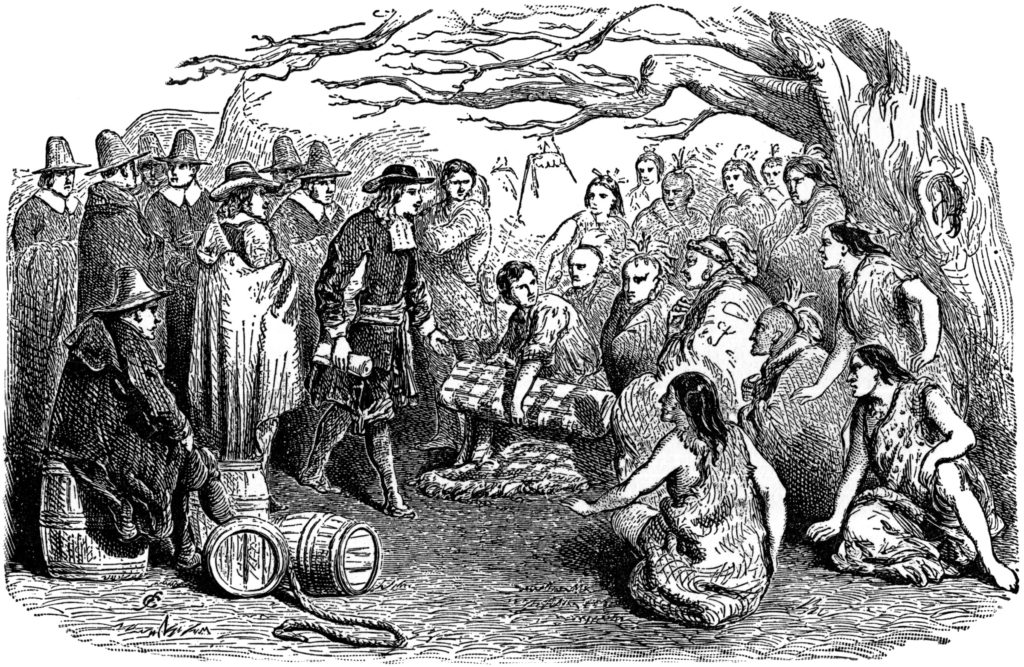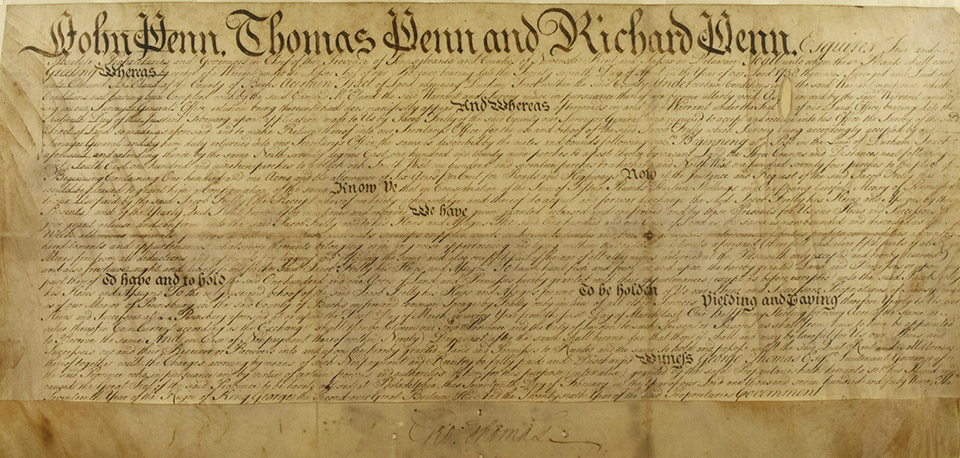European Settlement
William Penn, the famed founder of Pennsylvania, sought to create a Quaker colony in the New World organized around religious freedom in a non-exclusive community. In 1681 British King Charles II granted to Penn the huge expanse of territory to retire debts owed by the kingdom to Penn’s father, a prominent admiral and creditor.
Penn sought, in addition to ambitious settlers, a cadre of well-to-do merchants and gentry with the means to establish and oversee the settlement’s economy. Among wealthy Quakers in Ireland and England he promoted a business syndicate called the Free Society of Traders. As “First Purchasers” they would have preferred access to tracts of land in the new colony to develop farming, trade, mining, and manufacture. Penn deeded over several tracts throughout Bucks County, near present day Doylestown, Warwick, New Britain, Hilltown, and Durham, to the group of investors. Penn strove by treaty to fairly compensate the indigenous Lenni-Lenape residents of the territory, and believed he had fair title to occupy or sell the land as he saw fit.

Five thousand acres of the grant of 1681 were surveyed prior to the close of the century and located under the name of Durham, which comprised the whole of what is today Durham Township plus part of what is now Williams Township in Northampton County.
As one of the leading objects of the Free Society of Traders was the manufacture of iron, their attention was early directed to this region, and in 1701 Jacob Taylor, the surveyor-general of the province, surveyed 5,000 acres for this company, and called the tract Durham.
— Davis
How surveyor Taylor or someone else settled on the name Durham is speculation, with Davis making contradictory statements in his history. It’s conceivable the prospect of mining in this newly-surveyed tract inspired a place name hearkening back to County Durham, in northeast England, an early coal mining region.
The name, in all probability, was taken from the county and capital city of ancient Durham in England. It is quite possible also that the name, which occurs in deeds for Durham property as early as 1727, was suggested by Jeremiah Langhorne, who was interested in the same transfers of property.
— MacReynolds
Also unclear is the source of knowledge about valuable mineral deposits in this particular spot. The earlier Dutch and Swedish settlers may have known of it from Indians.
In the description of [the early, failed British colony] New Albion, published at London around 1648, there is mention made of “lead mines in stony hills,” ten leagues above the falls of Delaware, which probably had reference to the iron ore in the Durham hills, where a little lead has been found from time to time.
— Davis
The settling of land far from the burgeoning areas of Bristol and Philadelphia, which could have been purchased for equal cost and been closer to the population centers in those areas, should make it clear that agricultural ambitions did not drive interest in Durham, but rather iron ore and the potential profit when the ore was removed and smelted.
The Free Society of Traders fell quickly into disarray, between uncertain commitment from distant investors and resistance from other settlers to the investors’ control. The Durham tract was sold around 1726 to a group of wealthy and socially prominent shareholders residing in the colony, with the specific objective to build a mining and smelting operation. For more detail on this Company please see the following section on the charcoal iron furnace.
Interestingly enough, it was the raw ore found in the remote hills of Durham that brought Europeans here earlier than to the immediately surrounding townships. Mining and rudimentary smelting was recorded as early as 1698. Durham’s first European settlers were all but exclusively associated with the iron mine and furnace. Yet ownership of the land by the Free Society and its successor stock company delayed Durham’s formation as a political entity — a township. Durham’s neighbor to the west, Springfield, became a township in 1743, Bedminster in 1740, Haycock in 1763, Tinicum 1747, Nockamixon in 1746, but Durham not until 1775.
Sources
Bell, Herbert C. Durham Township. Philadelphia, PA, 1887.
Davis, William W.H. The History of Bucks County Pennsylvania: from the discovery of the Delaware to the present time. Doylestown, PA,1876 and 1905 editions.
MacReynolds, George, Place Names in Bucks County Pennsylvania. Doylestown, PA, 1955.
The Jacob Trelly Patent Deed
The image is a facsimile of a “Patent for one hundred and one acres of land in Durham Township,” (which today covers just under 6000 acres) “with some mining rights granted by John, Thomas and Richard Penn to Jacob Trelly for 15 pounds, 13 shillings and one penny and An annual quit rent of one half penny sterling for each acre. To be brought to Pennsbury Manor on March 1 of each year.” The deed was recorded in Philadelphia on February 17, 1743.
The framed facsimile print was presented to the Durham Historical Society by Bucks County Commissioners during a visit to Durham in 2005. It hangs in the Historical Society office in the Durham Mill building.

